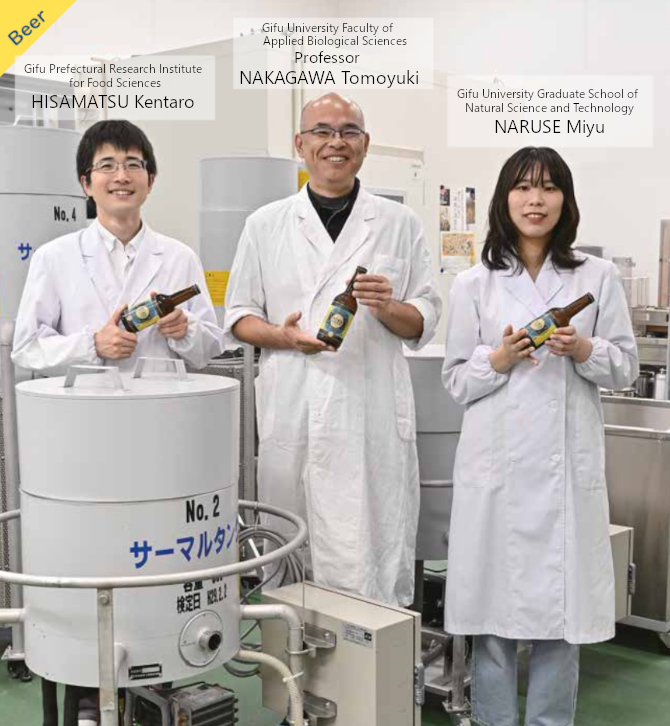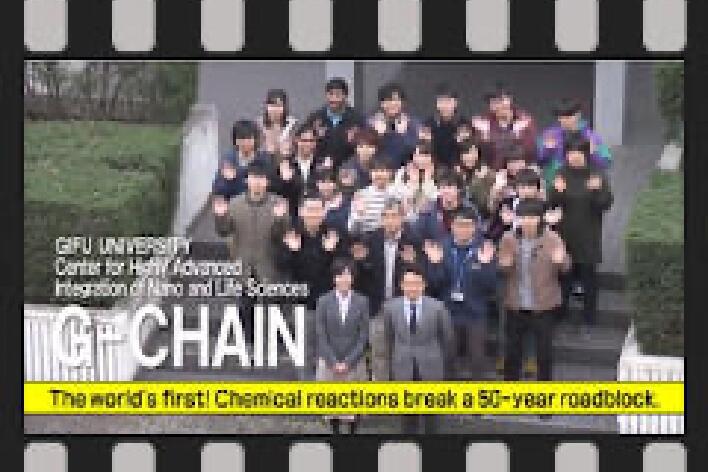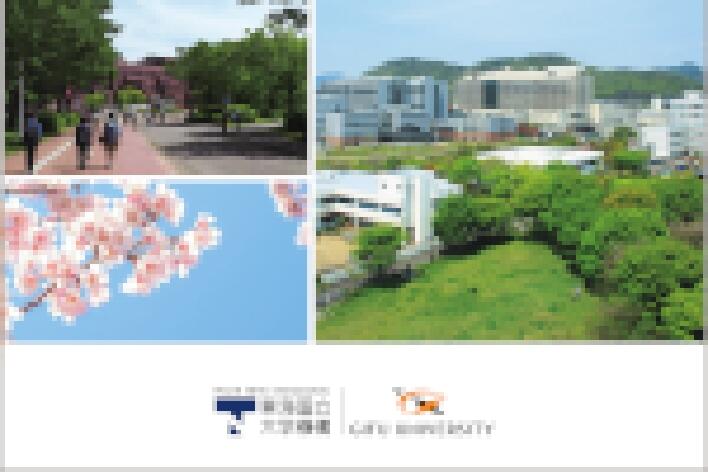Beer
*Information related to faculty members/students and graduate schools at Gifu University here are all that of the time of interviewing.

o commemorate its 100th anniversary, Gifu University's Faculty of Applied Biological Sciences collaborated with the Gifu Prefectural Research Institute for Food Sciences (GRIFS) and Gifu Beer Brewing to develop an original craft beer, "Tabounoharu Kakami." We spoke to the core members involved in this project to learn more.

Using the success of the Gifu Daishu Project as a stepping stone, the university members were emboldened to take on beer production.

strain GY115. It is a hardy, thriving yeast that can ferment
maltose, making it suitable for beer production. This yeast has
the potential to facilitate the creation of a new type of alcohol
that combines the qualities of both sake and beer.
The development of a craft beer utilizing yeast from Gifu University took a significant step forward in the summer of 2021, building upon the foundation laid by the Gifu Daishu Project that was first initiated in 2013. A number of professors operating in the Faculty of Applied Biological Sciences are dedicated to agricultural research with the overarching goal of providing practical scientific discoveries that can enhance our quality of life. Their focus on agriculture encompasses the study of grains, vegetables, and animals as food sources, as well as the ecological environment surrounding them. However, as research in the 21st century continues to become increasingly specialized, with genetic-level cell analysis becoming especially prevalent, horizontal connections between researchers have begun to diminish. In response, Gifu University department members revisited the fundamentals of their research approach, and began to contemplate the possibility of launching a cross-faculty project that would encourage collaboration among a diverse range of educators. Sake brewing emerged as a focal point for this process, offering a platform for teachers from various fields to collaborate on a wide range of topics, including rice cultivation, fertilizers, essential fermentation microorganisms, and the quality assessment of finished sake. In 2013, Gifu University established its "Practical Understanding of Alcohol and Food Culture" course. In tandem with this educational program, the Gifu Daishu Project gained real momentum when the university president expressed the desire to create a Gifu University-produced sake to commemorate the university's 70th anniversary.
 This led to the GY115 strain being selected as the "GU Yeast," Gifu University's chosen yeast in 2016. Sake brewing subsequently commenced in 2018 through a collaboration with Kuramoto Yamada in Yaotsu Town, Gifu Prefecture. By 2019, the Gifu Daishu sake varieties known as "Tabounoharu Gizan" and "Tabounoharu Kyokufu" were successfully produced, debuting at Gifu University's 70th-anniversary ceremony and receiving a notably positive response. Following on from this initial success, the development of craft beers, known as Gifu University Ales, emerged as a natural extension of the Gifu Daishu Project.
This led to the GY115 strain being selected as the "GU Yeast," Gifu University's chosen yeast in 2016. Sake brewing subsequently commenced in 2018 through a collaboration with Kuramoto Yamada in Yaotsu Town, Gifu Prefecture. By 2019, the Gifu Daishu sake varieties known as "Tabounoharu Gizan" and "Tabounoharu Kyokufu" were successfully produced, debuting at Gifu University's 70th-anniversary ceremony and receiving a notably positive response. Following on from this initial success, the development of craft beers, known as Gifu University Ales, emerged as a natural extension of the Gifu Daishu Project.
Developing an aromatic beer that highlights the special qualities of sake yeast

The yeast used in Gifu University Ale is the same GY115 strain used in Gifu Daishu. Just as there are many different human ethnicities all over the world, yeasts also have a wide range of qualities. These include beer yeast, baker's yeast, sake yeast, and wine yeast, among others. A vast variety of foods can be created by skillfully utilizing the unique characteristics of these different types of yeast. In other words, we humans have successfully domesticated yeast to suit our purposes.
Sake yeast, cultivated over a number of years, is generally specialized in metabolizing glucose, which is generated by breaking down starch in rice. Sake production harnesses the enzymatic power of koji (rice mold) to break down starch present in the rice into its smallest units, taking the form of glucose, which is then consumed by the sake yeast. In contrast, beer production involves the use of malt, where enzymes are activated to break down starch into maltose, a sugar composed of two glucose molecules. Traditional sake yeast, having been selectively bred to focus on consuming glucose, cannot ferment maltose. Despite this specialization, Japanese brewers have selectively bred and evolved sake yeast to give sake its rich aroma. Recognizing the potential for utilizing the aromatic qualities of sake yeast, we looked into the GY115 strain, a sake yeast capable of fermenting maltose, in more detail. This strain, originally designed for sake production, exhibits the unique ability to metabolize maltose and produce alcohol. Recognizing the potential value of this opportunity, we decided to use the GY115 strain to create a distinct beer with a Japanese sake-like aroma.
First, Mr. Hisamatsu from GRIFS conducted a preliminary study and determined that beer could be made using the GY115 strain. GRIFS' purpose is to support food companies in the prefecture. Thus, given the increasing attention that craft beer has been gaining in recent years, we hoped to conduct some form of research that would be useful in this field. Unfortunately, the breeding of new varieties of barley and hops, the raw materials for beer, would take years to generate any usable results. Conversely, if we could use the yeast that was successfully used in the Gifu Daishu Project, we would be able to quickly develop an original Gifu Prefecture beer. Furthermore, if GRIFS can successfully cultivate yeast and distribute it to breweries in the prefecture, businesses will gain valuable support. Mr. Hisamatsu graduated from Gifu University and studied in the laboratory next to mine when he was a student, so we decided to work together with GRIFS to advance this project.
Using GU Yeast to propel Gifu Prefecture into the world of craft beer

University Faculty of Agriculture/Faculty of Applied Biological Sciences' 100th
Anniversary Celebration held in June 2023. "Tabounoharu Kakami" can be purchased
at the Nagaragawa Department Store and THE GIFTS SHOP, as well as at other
retailers, in Gifu City.
Ms. Naruse, a student at the Graduate School of Natural Science and Technology, played a crucial role in investigating the relevant yeast properties as a part of the Food Microbiology Laboratory's activities. Similar to the approach taken during the creation of the Gifu Daishu sake, approximately 50 types of stored yeast were inoculated onto a maltose-containing medium. The study focused on determining how many colonies (clusters of yeast cells) could form under specific conditions, which ultimately enabled us to select the yeast most suitable for beer brewing.
The experimentation process began at GRIFS, starting with small-scale brewing of 100 milliliters. Gradually, the brewing was scaled up, culminating in the completion of a prototype beer in a 15-liter tank. When I tasted the beer for the first time, it certainly exceeded my expectations. It boasted a refreshing flavor and easy-to-drink quality, with the sake yeast offering a distinctive fruity aroma. To bring this creation to the market, production was entrusted to Gifu Beer Brewing Co. Ltd. in Gifu City, with locally harvested yuzu peels from Seki City incorporated to impart a gentle aroma. The resulting Gifu University Ale, "Tabounoharu Kakami," made its debut at the 100th-anniversary celebration of the Faculty of Applied Biological Sciences. The attendees provided positive feedback, with many commenting that it tasted much better than I had anticipated.
Going forward, the goal is to contribute to businesses in Gifu Prefecture by ensuring that GU Yeast is widely employed.
 In the midst of the nationwide craft beer boom, the prospect of Gifu Prefecture being recognized for its unique beers crafted with wild yeast is an exciting one. Envisioning a future where Gifu Prefecture becomes a global craft beer hub is a real possibility. Breweries throughout the prefecture are now producing distinctive beers using GU Yeast, attracting beer enthusiasts from both Japan and abroad who enjoy touring the breweries. This vision of the future holds the promise of something truly wonderful.
In the midst of the nationwide craft beer boom, the prospect of Gifu Prefecture being recognized for its unique beers crafted with wild yeast is an exciting one. Envisioning a future where Gifu Prefecture becomes a global craft beer hub is a real possibility. Breweries throughout the prefecture are now producing distinctive beers using GU Yeast, attracting beer enthusiasts from both Japan and abroad who enjoy touring the breweries. This vision of the future holds the promise of something truly wonderful.


We produce our original craft beer at a brewery near Inaba Shrine, and can be purchased at our affiliated beer bar, "Tap Room YOROCA." When we received a call from GRIFS to collaborate on brewing Gifu University Ale, it marked my first experience with brewing using sake yeast, making it a valuable learning opportunity. A crucial aspect of this process was the use of the Kaminoho variety of yuzu as an additional ingredient, one that enhances the fruity flavor imparted by the GY115 sake yeast strain. The result is an easy-to-drink beer with a delightful flavor that consistently garners commendations. We currently employ an app to gather data for each production batch, allowing us to make continuous improvements to our brewing process. We encourage you to experience and savor this unique beer at least once.





Professor Nakagawa appreciated one of our rejected label designs for the Gifu Daishu sake "Tabounoharu Gizan/Kyokufu" varieties. We therefore decided to reintroduce it with a modification to the color scheme, adopting a vibrant and fruity yuzu-esque color palette (a combination of green and yellow). The Japanese characters for "A Hopeful Spring" draw inspiration from a tombstone constructed during the Eastern Jin Dynasty in China, while the "Kakami" logo is based on an even older tensho (seal script) calligraphic design.
Gifu University Faculty of Education
Professor YAMAMOTO Masayuki






